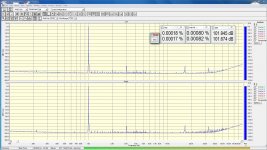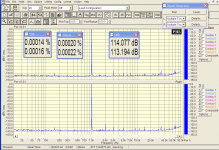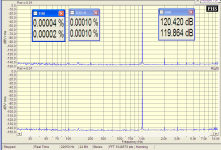FFT
Hi Keane,
Frankly, I've little faith in emulators and alike. The reason I stick with ASIO drivers is that they talk directly to the hardware. This way the response doesn't depend on unpredictable latencies of Windows (you know, Windows isn't a truly real time OS). How these issues are solved in Linux, I don't know.
BTW, It's said that the ASIO driver of the 'much-praised' Xonar Essence, is in fact an emulation. It doesn't talk directly to the DACs and ADCs, rather via DirectX, or WDM or whatsoever thingy. If it's true, it explains a lot.
See attachment for a FFT routine written in C. It consist of two part: four1() is the actual (discrete) transform, while realfft() is an application of it. The latter transforms an array of real data samples (pointed by datain) into pairs of real and imaginary components (pointed by datout). If the variable called sign is <0 this routine performs an inverse FFT.
If you are unfamiliar with the C language, well, it quite easy to understand. Besides, I think that sooner or later, you will switch to it anyhow (or to a similar language).
Cheers,
E.
The truth is grave, as always. On Linux, I have to use open-source drivers developed by independent hobbyists. I wonder if the linux drivers work better? Wine emulates DirectSound and Wave Out; do you use a different interface? I actually discovered while messing around that Wine did better at some sound-related task than when I actually used the original windows library. I think I lost that info when my HD died though.
Hi Keane,
Frankly, I've little faith in emulators and alike. The reason I stick with ASIO drivers is that they talk directly to the hardware. This way the response doesn't depend on unpredictable latencies of Windows (you know, Windows isn't a truly real time OS). How these issues are solved in Linux, I don't know.
BTW, It's said that the ASIO driver of the 'much-praised' Xonar Essence, is in fact an emulation. It doesn't talk directly to the DACs and ADCs, rather via DirectX, or WDM or whatsoever thingy. If it's true, it explains a lot.
Researching FFT is frustrating. I get the impression that the basic algorithm is simple, but whenever people write about it they use so much terminology it sounds like another language. I seem to learn more when I just look at the code to see what's going on. A picture is gradually forming in my head though.
See attachment for a FFT routine written in C. It consist of two part: four1() is the actual (discrete) transform, while realfft() is an application of it. The latter transforms an array of real data samples (pointed by datain) into pairs of real and imaginary components (pointed by datout). If the variable called sign is <0 this routine performs an inverse FFT.
If you are unfamiliar with the C language, well, it quite easy to understand. Besides, I think that sooner or later, you will switch to it anyhow (or to a similar language).
Cheers,
E.
Attachments
The official specs of the Xonar are over-flattered.
The official specs of the L22 are under-flattered.
As for the Xonar, I can't measure right now (as I've sold this card as soon as possible), but regarding the L22, the distortion of the ADC and DAC together at 1kHz is 2ppm. See pic.
Good morning Edmond!
That would be a big surprise and I would be very curious if you could independently (not "because I said so" as usual) substantiate this claim.
The L22 uses OP275 opamps, which are specified at 6ppm distortions (@1KHz and +4dB) and no less than 6nV/rtHz noise. Even the "poor" NJM2114 are specified at 5ppm (@1KHz and +4dB) and 2.7nV/rtHz and of course the replacement LM4562's are much better.
It would be interesting to find out how the whole signal chain can have 2ppm distortion when only the DAC opamps do have 6ppm. I am suspecting your comparison between the L22 and the Xonar to be (as usual) biased and not apple to apple.
As I already said, the DAC in the L22 is identical with the DAC in the Xonar, while the ADC in the L22 (AK5394A) is not better than the Xonar's Cirrus flagship CS5381. I can concede that the L22 is using a much better TXO, with less jitter, a much better power supply, with less noise (although I believe the PS is not the most important noise source in an internal PCI card), therefore less distortions and noise, so that overall the L22 performs maybe slightly better than a Xonar. I'll let everybody make their own judgement if a few ppm less (if any at all) in distortions are worth an extra 400 squid.
Researching FFT is frustrating. I get the impression that the basic algorithm is simple, but whenever people write about it they use so much terminology it sounds like another language.
Hi Kean,
Have you come across this site? You may find it useful.
[...]
Talking about shielding, I agree, the Xonar shielding is not effective. Though it must be better than... nothing for the L22 board.
As of 24 June 2012, this is the opinion of someone else:
'Among our preferred three vendors, the best sounding PCI audio card we’ve tested and abused for 5 years is the Lynx Studio Two B. It’s simply transparent with an incredible signal to noise ratio and beefy, natural analog sound. The Lynx Studio Two B is our preferred card for laying down tracks, voice over, mixing and pretty much any audio task. Our ears have not heard a better sounding PCI audio card. It also has some of the best shielding technology and does not pick up noise and interference inside the PC. '
See this article.
It happens that the L22 uses the same TI 1792A DAC as the Xonar, so I doubt there's much reason to get better results. The Xonar uses the latest generation of AK ADC while the L22 uses the same ADC as the (drums are rolling) EMU1212 that you just mentioned as crap.
Indeed, crap. Not because of the hardware, but because of the software.
Regarding the hardware, the performances doesn't solely rely on the DACs and ADCs. What really matters is the choice of all components, (op-amps, Rs, Cs, low jitter clock etc.) PCB layout, firmware and software. In all these respects Lynxstudio excels and that is what I need.
The Xonar works perfectly fine with the generic ASIO drivers, at least in my PC.
If it fill your needs I'm happy for you.
I may call the L22 an overpriced and outdated (it's still PCI) piece of hardware.
True, it's expensive, though just as expensive as any other professional sound card (RME for example).
Outdated because of PCI? As long as motherboards with PCI slots are manufactured in abundance, I don't care. It's the performance that matters.
It's the accessories and software (mixer, etc...) that brings value to this sound card, not the ADC/DAC hardware which is absolutely average.
It's precisely the opposite: their mixer, that is, the layout of it, could be better.
I have not tested a L22,
That's the reason you don't know what you are talking about.
but I doubt it would justify anywhere the x5 price over the Xonar.
Buy it 2nd hand on ebay, just as I did, and you will be happy.
For the price of the L22 you could buy a second hand HP35660A or HP35665A spectrum analyzer. That, and a simple notch filter, would beat the last drop of any sound card............
These analyzers have a dynamic range of only 70dB. Even with an added notch filter, it doesn't come close to my setup: 150dB.
Last but not least, why do you think I finally bought a L22? Not because I like to spend a lot of money. No!
It was because after years of experimenting with consumer sound cards I'm through with it, completely. As a matter of fact, that was a waste of time and money.
Last but not least, why do you think I finally bought a L22? Not because I like to spend a lot of money. No!
It was because after years of experimenting with consumer sound cards I'm through with it, completely.
You may be through, but the market and technology are not. Confined in the past, this is what I call "the JC syndrome". Everything that's good happened 30...20...10 years ago, isn't it?
Cone on, please don't talk through your hat.
This 10 year old card still performs better, see post 1084.
Oh, and what about a "Waly syndrome": always talking back without making any sense.
This 10 year old card still performs better, see post 1084.
Oh, and what about a "Waly syndrome": always talking back without making any sense.
I have that book - it's really excellent 🙂
And this is my other card, that I was able to get for 50 squid (so under 10% the price of an L22).
It's a little noisy (noisier than the L22 and the Xonar), but then carefully count the zeroes in the THD box and check the noise floor... This is the stock unit, before any mods (better opamps, etc...). The noise distribution is clearly due to the lack of shielding in the noisy PC case, another thing a handy man could improve (thinking myself to add a mu-metal casing, not an easy job though).
Guess the brand and model (hint: it is still current and available on the market, both as new (100 squid) and used (under 50 squid), and has W7 x64 rock solid drivers available).
With 140dB noise floor, 2ppm distortions (@1KHz and 0dB), balanced inputs/outputs, digital I/O too, who would need anything more than this card for audio (except the cranky old dutch simulation afficionados).
It's a little noisy (noisier than the L22 and the Xonar), but then carefully count the zeroes in the THD box and check the noise floor... This is the stock unit, before any mods (better opamps, etc...). The noise distribution is clearly due to the lack of shielding in the noisy PC case, another thing a handy man could improve (thinking myself to add a mu-metal casing, not an easy job though).
Guess the brand and model (hint: it is still current and available on the market, both as new (100 squid) and used (under 50 squid), and has W7 x64 rock solid drivers available).
With 140dB noise floor, 2ppm distortions (@1KHz and 0dB), balanced inputs/outputs, digital I/O too, who would need anything more than this card for audio (except the cranky old dutch simulation afficionados).
Attachments
L22, same conditions..
Less noisy, as expected and already mentioned. You would think it's worth the money? 😀
A brand new in box of mine just went on EBay UK for the stunning price of... 38 squid 😀😀😀. Of course, if one already owes a L22, there's little reason to look for anything else. Otherwise, as a hobbyst, to buy a new LynxTwo or L22 today you have to be either a snob, or equally rich and stupid.
Last edited:
The problem with ALL these damn sound cards, is the only decent ones are the ones that slot into a motherboard. I want this performance on a USB line input level unit. I tried a few(EMU, etc). All crap. But, just for doing comparative measurements, I suppose they will do. Maybe we could stop throwing eggs at each other and design a really good stand lone card. 😀.
The problem with ALL these damn sound cards, is the only decent ones are the ones that slot into a motherboard. I want this performance on a USB line input level unit. I tried a few(EMU, etc). All crap. But, just for doing comparative measurements, I suppose they will do. Maybe we could stop throwing eggs at each other and design a really good stand lone card.
I think Twisted Pear are working on ESS ADC too
but maybe non ESS parts would be preferable for a "open" design
2 Waly
"We are not so rich to buy cheap things.."
Try something like this (analogue loopback, BW10kHz) with your card..And more than ten years ago.you have to be either a snob, or equally rich and stupid.
"We are not so rich to buy cheap things.."
Attachments
DiAna
And this is what can be achieved with my distortion analyzer and 10 years old sound card:
Test signal: 19201Hz, BW: 250kHz, measurement floor < -160dB. Harmonics are around 2ppb. I wonder if this is possible with a Xonar Essence, despite its gold plated bracket. 🙄
(NB: All done in software; no analog distortion magnifier or notch filter has been used.)
And this is what can be achieved with my distortion analyzer and 10 years old sound card:
Test signal: 19201Hz, BW: 250kHz, measurement floor < -160dB. Harmonics are around 2ppb. I wonder if this is possible with a Xonar Essence, despite its gold plated bracket. 🙄
(NB: All done in software; no analog distortion magnifier or notch filter has been used.)
Attachments
Last edited:
Edmond, I know I asked before but I still don't get how you are able to generate a 19 kHz test tone with -160 dB harmonics in a 250 kHz bandwidth. With the sound card? How????
Hi Harry,
I don't generate a 19 kHz test tone with -160 dB harmonics, instead, the measurement floor of the whole setup is 160dB down. How? Sorry, I can't tell because of commercial interest. The same applies to that 250kHz bandwidth, which, btw, is not the BW of the sound card (normally Fs/2), rather a constraint imposed by the software.
(The 'software' BW is much higher than Fs/2. Hint: think of undersampling).
Cheers,
E.
I don't generate a 19 kHz test tone with -160 dB harmonics, instead, the measurement floor of the whole setup is 160dB down. How? Sorry, I can't tell because of commercial interest. The same applies to that 250kHz bandwidth, which, btw, is not the BW of the sound card (normally Fs/2), rather a constraint imposed by the software.
(The 'software' BW is much higher than Fs/2. Hint: think of undersampling).
Cheers,
E.
Hi Harry,
I don't generate a 19 kHz test tone with -160 dB harmonics
Then I obviously don't understand what you mean by:
Test signal: 19201Hz, BW: 250kHz … Harmonics are around 2ppb
Or your screenshot showing a sinewave and a measurement reading that states "THD = -168.2 dB"
Where is that sinewave coming from?
- Status
- Not open for further replies.
- Home
- Amplifiers
- Solid State
- Has anyone seen this front-end before?



